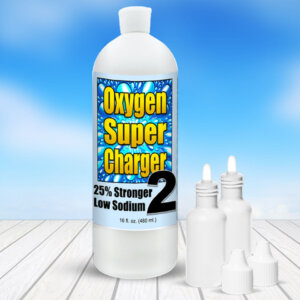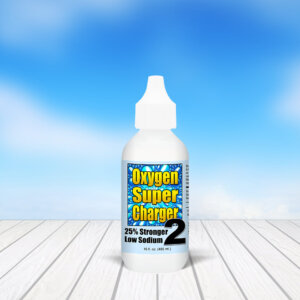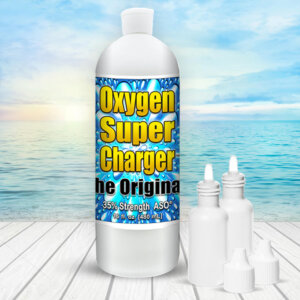Oxygen Stamina
Oxygen’s role in stamina and endurance, and strength is critical. To see how O2 plays a role in your sports endurance and stamina, let’s look at how O2 functions in your body. Here is an except part of our video series so you can better see the link between physical endurance and oxygen stamina:
You body stores its fuel, known as carbohydrates, in the form of glycogen, mostly in the liver & smaller amounts in the muscles.
When you put your muscles to work the glycogen is transformed into glucose then the glucose is burned by the body for the energy the muscles need.
Q: What does your body absolutely need to transform glycogen to glucose?
OXYGEN!
So, the more oxygen you have available for your cells to use, the faster the transformation of glycogen into glucose. And the faster the transformation, the more energy and stamina you’ll have.
If you could super-load your blood and cells with available oxygen, the engine of your body will be able to reach its maximum capacity!
You body stores its fuel, known as carbohydrates, in the form of glycogen, mostly in the liver & smaller amounts in the muscles.
When you put your muscles to work the glycogen is transformed into glucose then the glucose is burned by the body for the energy the muscles need.
Q: What does your body absolutely need to transform glycogen to glucose?
OXYGEN!
So, the more oxygen you have available for your cells to use, the faster the transformation of glycogen into glucose. And the faster the transformation, the more energy and stamina you’ll have.
If you could super-load your blood and cells with available oxygen, the engine of your body will be able to reach its maximum capacity!
— Oxygen’s Role in Athletic Stamina and Endurance

Put another way, in this article on Exhaustion, in the World of Sports Science by Dr-Fo. Oxygen for energy at any age. A closer look at blood oxygen energy and adenosine triphosphate (ATP):
When the body requires energy for activities lasting longer than approximately 90 seconds, it will fuel itself through the production of the energy source adenosine triphosphate (ATP), using available stores of glucose. ATP is produced as the culmination of a process whereby the bodily carbohydrate stores, glycogen, are converted to glucose and transported through the red blood cells of the bloodstream to the muscles where the ATP conversion occurs. The red blood cells also transport the oxygen required to metabolize, or burn, this fuel; the blood also removes the waste products and carbon dioxide produced in this process.
The simplest and most common form of physical fatigue is when the body simply runs out of the primary sources of carbohydrate required to manufacture energy in the form of ATP. When the body determines that it has no more glycogen available to it (the liver regulates the level of these sugars present in the bloodstream), it will revert to the consumption of stored fats to convert into energy sources. Fats are a comparatively lesser, more inefficient fuel for energy production. As with any machine, when the fuel sources are spent, the body cannot continue to perform. An inability to produce energy does not only affect the muscles and other working components of the body, but also the functioning of the brain and the central nervous system; a depletion of physical energy stores will cause significant reductions in concentration and mental function.
When the body requires energy for activities lasting longer than approximately 90 seconds, it will fuel itself through the production of the energy source adenosine triphosphate (ATP), using available stores of glucose. ATP is produced as the culmination of a process whereby the bodily carbohydrate stores, glycogen, are converted to glucose and transported through the red blood cells of the bloodstream to the muscles where the ATP conversion occurs. The red blood cells also transport the oxygen required to metabolize, or burn, this fuel; the blood also removes the waste products and carbon dioxide produced in this process.
The simplest and most common form of physical fatigue is when the body simply runs out of the primary sources of carbohydrate required to manufacture energy in the form of ATP. When the body determines that it has no more glycogen available to it (the liver regulates the level of these sugars present in the bloodstream), it will revert to the consumption of stored fats to convert into energy sources. Fats are a comparatively lesser, more inefficient fuel for energy production. As with any machine, when the fuel sources are spent, the body cannot continue to perform. An inability to produce energy does not only affect the muscles and other working components of the body, but also the functioning of the brain and the central nervous system; a depletion of physical energy stores will cause significant reductions in concentration and mental function.
— Dr. Fo

Improve Stamina with Oxygen
You improve O2 and endurance by improving the O2 available to the cells. A product like OxygenSuperCharger is an excellent supplement to enhance the available blood O2 needed for stamina and endurance during sports or just everyday activities. OxygenSuperCharger is ASO, Bio-available Liquid Oxygen, in a safe pH-neutral liquid form. So to improve O2 energy, consider a premium product like OxygenSuperCharger.

-

Ultra Strength OxygenSuperCharger2, 25% Stronger, 16–Ounce Bottle
$119.97 Add to cart -

Ultra Strength OxygenSuperCharger2, 25% Stronger, 2–Ounce (Sample Size)
$35.97 Add to cart -

Original 35% Strength OxygenSuperCharger, 16–Ounce Bottle
$96.97 Add to cart -

Original 35% Strength OxygenSuperCharger, 2–Ounce (Sample Size)
$27.97 Add to cart -

MineralSuperCharger, Premium Multi-Mineral Supplement, 32-Ounce Quart
$98.97 Add to cart -

MineralSuperCharger, Premium Multi-Mineral Supplement, 8-Ounce (Sample Size)
$29.97 Add to cart -

Zinc – Plant-Sourced Mineral Concentrate, 16-ounce
$24.97 Add to cart -

O4 Nasal Spray with Zinc
$14.97 Add to cart






